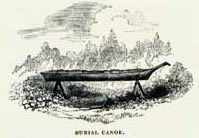
Lesson Seven: The Changing World of Pacific Northwest Indians
Burial canoe at the mouth of the Columbia River. (Edward Belcher, Narrative of a Voyage Round the World. London, 1843. Vol. 1, p.292.)
In the decades between 1830 and 1860, two fundamental shifts of power occurred in the American Northwest. One took place between non-Indian contestants for the region. British dominance in the area, expressed mainly through the activities of the Hudson's Bay Company, diminished somewhat, giving the United States a stronger hold on the region and ultimately, in 1846, that portion of it south of the 49th parallel. (This is the focus of the next lesson.) The other major shift occurred between Indians and non-Indians, as native peoples found themselves increasingly on the defensive and subject to the policies and preferences of colonizers from Europe and the United States. For the lands that became the states of Washington, Idaho, and Oregon, these changes meant that by 1860 people from the United States were essentially in control of the territory; at the same time British and Canadian colonizers were increasingly asserting colonial control over native societies in the land that became British Columbia, too. How native peoples were colonized by American and British "settlement" forms the subject of Unit IV. Here, I want to focus on how changes to the worlds of the region's Indians, during the period of the land-based fur trade, contributed to the shift in power that eventually led to the dispossession of so many native peoples. I have already pointed out (Lesson 6) that fur traders differed from settlers in that they did not come to establish permanent towns and farms or to dispossess Indians. Yet the interaction of these fur traders with Indians, combined with the contact of newly arriving missionaries, did facilitate the dispossession that eventually resulted.
As with the era of the maritime fur trade, it was epidemic diseases—which, again, were unknown to Indians prior to contact with Europeans, and therefore illnesses against which natives had no immunities and little resistance—which had the most substantial impact upon native populations in the era before the mid-19th century. Epidemics such as smallpox, measles, and influenza did not strike Indians once; rather they recurred over the decades, meaning that groups of Indians who were recovering from one epidemic would likely be hit by another. Perhaps a band or tribe had experienced smallpox and acquired some immunity to that disease, for example, but the next epidemic to strike might be measles or typhoid. Successive outbreaks of different diseases devastated native peoples. The impact was not spread evenly across the region; groups on the Columbia Plateau, for example, apparently suffered less than those along the coast. But disease reached every group of natives, and not solely the epidemic varieties. Natives were also struck by illnesses that became endemic, including venereal disease and tuberculosis. These afflictions weakened Indian societies just as non-Indian colonizers approached the Pacific Northwest, and thus diminished natives' ability to resist colonization.
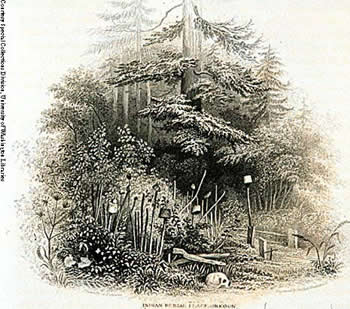
Indian burial place, Willamette Valley, Oregon. (Charles Wilkes, Narrative of the United States Exploring Expedition During the Years 1838, 1839, 1840, 1841, 1842. Philadelphia, Lea and Blanchard, 1845. Vol. 5, p. 219. Sketch by A. T. Agate, 1841.)
An outbreak of malaria between 1830 and 1833 offers a powerful illustration of the effect of diseases upon relations between Indians and non-Indians in the Pacific Northwest. Over the course of three years, beginning in 1830, malaria swept through groups of Indians along the lower Columbia and Willamette rivers. The disease was probably brought to the region either by sailing vessels or by traders and trappers who had arrived from the malarial Mississippi River valley. Carried along by the mosquito Anopheles malculipennis, which flourishes in summer and which ranges between coastal areas and the Cascade Mountains, malaria broke out for three straight summer seasons. It hit especially hard in the vicinity around the future site of Portland, the swampy location of which had a special concentration of mosquitoes. From Oregon the disease spread south to the Central Valley of California, probably carried by one of the HBC trapping expeditions to move in that direction. Before the epidemic struck, in 1830, there are estimated to have been 13,940 Indians in the lower Columbia and Willamette valleys (and this figure, remember, represents an estimate of how many had already survived epidemics of smallpox and other diseases); by 1841 there were only an estimated 1175 natives remaining. In other words, the depopulation over about one decade's time—largely the result of malaria—was approximately 92%. White observers recounted entire villages destroyed, with nobody left behind to tend to the dead and dying.
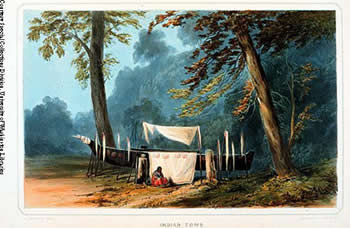
Consider for a moment how such a staggering rate of mortality would influence regional history. First, imagine how the culture of Indian peoples would have been affected if nine out of every ten members of a family, band, or tribe died off. Who would be left to procure food and shelter, care for the children, and carry on traditions? What would happen to a group's spiritual and medicinal practices, given the apparent failure of those practices in the face of epidemic diseases? What traces would be left of groups whose few remaining survivors ran off to join other groups? Second, think about the impact of this disease on relations between Indians and non-Indians. If Indian groups had recently seen their populations reduced by ninety percent, how successfully might we expect them to have resisted the incursion of non-Indians into their territory? Moreover, how would diseases have influenced the perceptions of colonizers in the territory?
An Indian burial canoe, by Captain Henry J. Warre. (Henry James Warre, Sketches in North America and the Oregon Territory. London, Dickinson & Co., 1848. Plate 13.)
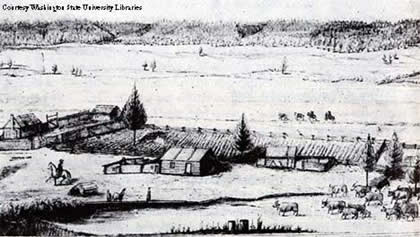
Tshimakain, the American Board's Spokane Mission, 1843. (James R. Gibson, Farming the Frontier, 156. Sketch by Charles Geyer. Papers of Elkanan and Mary Richardson Walker, 1821-1938. WSU, Pullman.)
When American missionaries and settlers began to arrive during the 1830s and early 1840s, they viewed the Willamette Valley as a relatively unpopulated area, as "free land" upon which they might settle without extensive negotiations with Indians over rights to the land—and because of the effects of malaria their perception was not entirely wrong. The region had been substantially depopulated. It is no accident that the initial influx of settlers to the Northwest flowed so heavily to the Willamette. It possessed great farmland, to be sure, but it also possessed relatively few native occupants who might challenge non-Indian control of the territory. In some respects disease paved the way for the arrival of settlers. And once settlers had arrived, they seized upon the apparent depopulation of the native Northwest as an excuse or justification for their own occupation of the land. The Indians, they repeated to themselves, were all dying off—so what rights of theirs needed to be respected?
Epidemic diseases affected Indians and non-Indians differently. Some fur traders in the vicinity of Fort Vancouver, for example, were also struck by malaria, but their losses were very small, especially by contrast to native losses. Epidemic disease helped to differentiate between natives and non-natives, then, and also helped to shift the balance of power between them. At the same time, however, the spread of illness from one group to another reminds us that the two groups were in some ways being integrated into a single Northwestern society—not as equals, by any means, but nonetheless sharing much together. The fur trade was responsible for some of this integration, as was the activity of missionaries.
British and American fur trade companies consisted almost entirely of male employees. When employees of the North West or Hudson's Bay companies initially went to work in the Columbia Department, they were not accompanied by "European" or "white" women. Rather, the only women with whom they came into contact were "full-blood" Indian women, i.e. women entirely of native ancestry. Fur traders formed relationships with these Indian women, and with them had "mixed-blood" or metis children. In essence, although we generally speak about the fur-trade era as one of natives and non-natives, Indians and "whites," in fact the different groups were starting families together and bringing about something of a mixing of the two peoples.
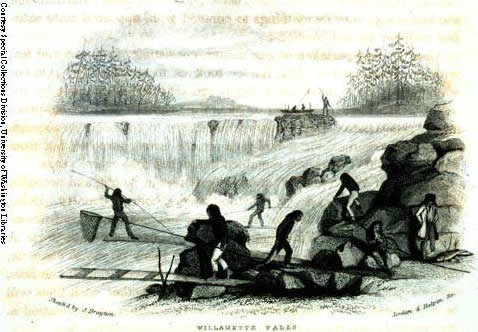
Willamette Falls, J. Drayton, 1841. (Charles Wilkes, Narrative of the United States Exploring Expedition During the Years 1838, 1839, 1840, 1841, 1842. Philadelphia, Lea and Blanchard, 1845. Vol. 4, p. 345.) University of Washington Special Collections.
It is important to keep in mind that, while personal needs and motives affected these relationships between male fur traders and Indian women, there were also larger social, economic, and political matters at stake. Both the trading companies and the native societies regarded relationships between fur traders and their partners partly in economic terms. Fur traders hoped to develop a closer relationship with influential Indians and to acquire the labor and other skills of wives and their relatives; Indian families similarly hoped that these relationships would result in favoritism toward them in the trade. "Marriage" in the fur country helped to cement ties between trading companies and Indian groups. Of course, they were not purely business transactions; they also addressed personal needs and opportunities. Yet in these regards the relationships did not follow one pattern. Some seem, in retrospect, to have been quite exploitative, for some fur traders simply abandoned their wives and children upon leaving a territory or going back to England. Other traders, however, developed close ties to their wives and offspring, and remained with them for the rest of their lives rather than return to Europe. On both sides, there was a degree of accommodation to the other's culture. Over time, however, it seems that the pressure on Indians to conform to white ways became greater. One scholar (Sylvia Van Kirk, Many Tender Ties: Women in Fur-Trade Society, 1670-1870) has argued that fur traders increasingly preferred "mixed-blood" to "full-blood" women as wives, and in other ways tried to pressure their female partners to abandon Indian ways and adopt British values. One example of this pressure is mentioned by George Simpson—the attempt to persuade Chinook mothers not to flatten their babies' heads. Another example comes from the realm of religion; many fur traders tried to persuade wives and children to become Christian.
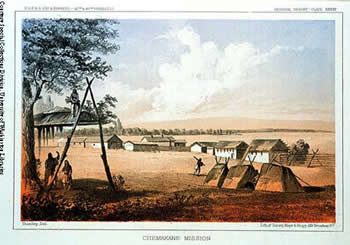
Chemakane Mission, J. M. Stanley, 1853. (Reports of Explorations and Surveys. Washington, D.C., 1857. Vol. 12, pt. 1. plate 34.) University of Washington Special Collections.
Missionaries exerted additional pressure on Indians to convert to European ways, specifically Christianity. As with intermarriage, there were many different shadings of religious interaction between Indians and non-Indians. Some native groups eagerly sought out Christianity, no doubt in part because their own spiritual beliefs had been found wanting in the face of epidemic disease and other aspects of colonization. Natives did not always regard Christianity, however, as a replacement for their own religion. They were often more eclectic than that, and found ways of merging native and European beliefs. Other Indians did not respond so well to the message of Christianity. Schwantes (pp. 83-90) recaps the Cayuse response to the missionary efforts of Marcus and Narcissa Whitman. Like other Protestants, the Whitmans had succeeded in recruiting very few natives for Christ after establishing their mission near present day Walla Walla. Over time, as a result, they despaired of converting native peoples and decided to focus their efforts on the growing number of white settlers arriving from the United States. Marcus Whitman explained this change of mission: "It does not concern me so much what is to become of any particular set of Indians, as to give them the offer of salvation through the gospel and the opportunity of civilization....I have no doubt our greatest work is to be to aid the white settlement of this country and help to found its religious institutions." Whitman went on to explain why natives would not possibly be ably to resist the influx of settlers in comments that combined Christian with biological prophecy: "For the [Biblical] Command is multiply and replenish the Earth, neither of which the Indians obey....How can they stand in the way of others who do both?" How indeed.
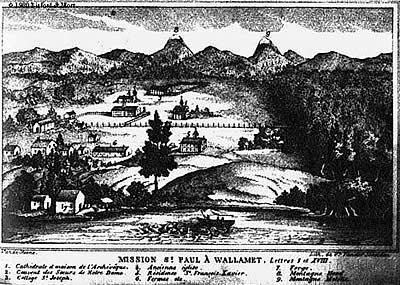
St. Paul Catholic Mission, 1847. (Harvey J. McKay, St. Paul, Oregon, 1830-1890. Portland, 1980, 15. Source credited to St. Paul Mission Historical Society.)
(Whitman was citing Genesis 9:7, a more modern version of which states, "As for you, be fruitful and increase in number; multiply on the earth and increase upon it." His thought was that Christians would go forth and multiply and replenish the earth—in this case the Pacific Northwest—while Indians seemed to be dying away.)
When the first missionaries arrived in the Pacific Northwest, in 1834, Indians outnumbered non-Indians by a substantial margin. Yet the kind of statement made by Whitman during the early 1840s suggests both just how the demographic balance was changing and just how confident white colonizers were about their eventual success in colonizing the Pacific Northwest. Christianity was one source of that confidence; biology (or, more specifically, an awareness of the impact of epidemic disease) was another. The Bible told Whitman and other Christians of their right and obligation to colonize all corners of the earth; the disappearing population of natives told them of the opportunities of colonizing parts of this specific corner of the earth without great resistance from Indians.
Protestants such as Marcus Whitman and Jason Lee did not have the field to themselves in this period. Catholic missionaries competed with them for Indian souls. Although both Catholics and Protestants sought to convert natives to Christianity, they did not proceed in their endeavors in the same way. Protestants generally proved more rigid in their approach to Indians; more insistent on rapid conversion and on outward signs of conversion such as shortened hair and white clothing; more nationalistic in their focus on American government and values; and more determined to live on fixed plots of land in order to show Indians how to settle down and farm. Francis Paul Prucha writes,
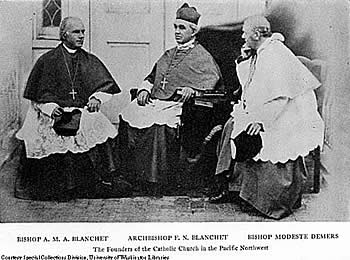
"For the Protestant conversion to take place, a total and external transformation was deemed necessary, and the Anglo-Protestants demanded ultimately the obliteration of Indian culture in its entirety-language, religion, ceremonies, social patterns. The Catholics were more likely to accept the Indians' nature, to accommodate themselves to the cultures they were seeking to make Christian. They studied Indian languages, appealed to the Indians' love of ceremonials with the Catholic liturgical splendors, and looked for evidences of an inner faith, not external conformity" ("Two Roads to Conversion: Protestant and Catholic Missionaries in the Pacific Northwest," Pacific Northwest Quarterly 79 [Oct. 1988]: 134).
Catholic missionaries were more likely to be of European origin, and did not share the Protestants' forceful American nationalism or their attachment to the U.S. government—which Indians of course regarded with suspicion. They proved more willing, too, to travel with and live among Indians. Thus some tribes, such as the Couer d'Alenes in Idaho, became predominantly Catholic and have remained so. And prominent Catholic missionaries such as Father Pierre-Jean de Smet, left behind invaluable accounts of native ways (see in particular Jacqueline Peterson with Laura Peers, Sacred Encounters: Father De Smet and the Indians of the Rocky Mountain West [Norman: University of Oklahoma Press, 1993].)
Bishop A. M. A. Blanchet, Archbishop L. N. Blanchet, and Bishop Modeste Demers, the founders of the Catholic Church in the Pacific Northwest. (Edwin Vincent O'Hara, Pioneer Catholic History of Oregon. Portland, 1911, 8.)
| Course Home | Previous Lesson | Next Lesson |